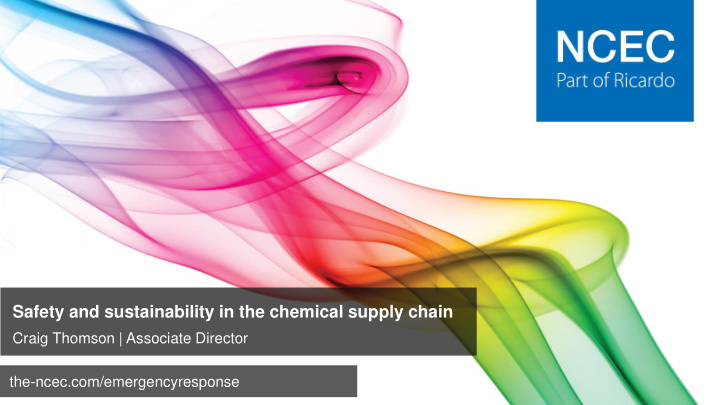



Safety and sustainability in the chemical supply chain Craig Thomson | Associate Director the-ncec.com/emergencyresponse
Agenda Four quadrants of emergency response Compliance How will Brexit affect your supply chain? Risk Management Sustainability What next? Tools to help
Four quadrants of emergency response NCEC – the four quadrants of emergency response
NCEC in numbers • 45 years • 8,000 calls • 550 companies • Multiple languages • 24/7 operations
Perspectives on emergency response Sustainability Risk Management Compliance
What are the regulations?
China • Local telephone number • Mandarin language response • 24/7 availability • Dedicated emergency response team • Physically answered in China • China’s National Registration Centre for Chemicals (NRCC)
European poison centres Notifier Appointed body Poison Poison Poison centre centre centre
Poison centres and emergency numbers • Medical advice only (often only to medical professionals) • In-country number only (no cross-border/global support) • No chemical spill advice • No multilingual capability • 24hr operations and resilience capability is varied • Best practice: • Two numbers on SDS section 1.4 / in-country numbers • One emergency response number on transport docs, labels, etc.
How will Brexit affect your supply chain?
Perspectives on emergency response Sustainability Risk Management Compliance
Risk
Risk – what do you see? Injury to Risk to Chemical driver public exposure Pollution to Pollution to a stream land Damage to Cost of Damage to shipment recovery assets Supply Missed Non- Impact on chain delivery compliance reputation confidence
Risk – reputational risks Source credit: https://www.latimes.com/cgnews-parts-of-maryland-city-under-shelter-after-hazmat-incident-20150530-story.html
Risk – “We are too good to be affected” “The set procedures we have in place for handling dangerous goods shipments, are stringent enough to prevent significant damage. In the unlikely event of a DG shipment being damaged, all staff involved with the handling have rigorous training and sufficient equipment to deal with the incident.”
ROI – cost of an incident • Accidents at work cost UK $14 billion a year • 2010/11 – 175 people killed at work • 200,000 reportable injuries (each >3 days off work) • Major injuries: fractures, amputations, chemical burns, loss of consciousness 16
ROI – cost of doing nothing 4 x fire trucks for 6 hours = $7,608 12 hours public health agency time = $1,551 36 hours of plant shut down = $277,080 Clean up contractor = $18,472 Fine = $38,483 Legal costs = $10,776 TOTAL = $353,970
ROI – cost of a farm incident Somerset – 2 Feb 2012. Firefighters battled the blaze for seven hours to prevent the fire from spreading to two other barns containing 25 tonnes of chemical fertiliser and one tonne of grain. 2 x fire appliances for 3 hours = $1,879 12 hours of environmental agency time = $1,533 Clean up contractor (6 hours) = $9,120 Fine = $38,000 Legal costs = $11,400 TOTAL = $61,932
ROI – placing a value on mitigation Health benefits $3,072,601 • Health service savings $10,024 • Reduction in lost work days or days lost through restricted activity $8,132 • Reduction of 1 fatality (road, site, home, etc.) $2,493,947 • Reduction in 2 serious medical issues $560,499 Time savings $1,112,395 • Reduction in time spent by emergency services $205,636 • Reduction in time roads closed or heavily congested $906,758 Environmental benefits $103,122 • Avoided Environment Agency involvement 10% of spills, traffic incidents and fires it would normally need $2,764 to attend • One case of serious aquatic damage avoided $100,358 Total $4,288,119
Perspectives on emergency response Sustainability Risk Management Compliance
Best practice – why is it required? • Providing a benchmark against which to measure • Raising standards across industry • Educating supply chain
Best practice – cefic role
cefic Guidelines • Level 1 (telephone-based) emergency response should be available at any time when an emergency occurs. • The Level 1 system must have the ability to receive calls in the local language, and English. • The caller’s connection to an emergency response expert should be performed as quickly as reasonably possible.
cefic Guidelines • The Level 1 responder must have access to appropriate information and networks in order to seek additional support. • Operatives should have a qualification that is sufficient to give them expert knowledge and understanding of chemicals. • Experienced in handling emergencies and can provide full advice to a variety of incidents, which should be proportional.
cefic Guidelines • The Level 1 responder should have sufficient training and experience to equip them with the practical elements of responding to an incident. • Level 1 responders should have awareness of the different regulatory regimes affecting the transport and supply of chemicals.
What next? ✓ Check your compliance (including poison centres) ✓ Revisit your supply chain risks ✓ Health check your risk management performance ✓ Check your emergency response systems measures up
Tools to help Global regulatory Business case for Global 24/7 telephone Guidelines for level 1 requirements emergency emergency response chemical emergency response helpline response Visit: the-ncec.com/resources
Contact me E: craig.thomson@ricardo.com T: +44 (0)1235 753 068 Craig Thomson W: www.the-ncec.com Associate Director
Recommend
More recommend